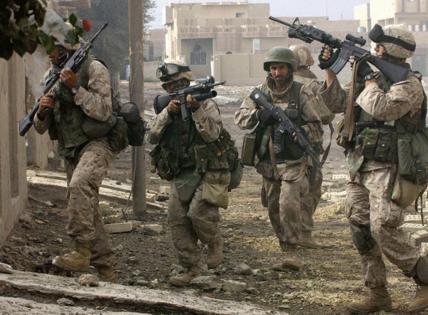James Stavridis: The nightmare Battle of Fallujah still has lessons to teach
Published in Op Eds
On Aug. 7, the Israeli war cabinet made a controversial decision to continue Israel Defense Forces (IDF) ground attacks against Hamas in Gaza, despite intermittent ceasefire efforts and the ongoing danger to the remaining hostages.
The decision has been condemned by many nations, including some — like France, the UK, Canada and Australia — that are generally more sympathetic to Israeli policy.
The security cabinet’s plan specifically targeted Gaza City as part of five objectives: rescuing the hostages; establishing complete security control of the city; demilitarizing all of Gaza; disarming Hamas; and creating a civil administration that excludes both Hamas and the Palestinian Authority. Within Israel, the plan has sparked significant opposition and triggered large-scale protests.
Israeli media reports that the plan includes an initial task for the IDF of taking full control of Gaza City (a city of around one million Palestinians) as well as refugee camps throughout the Gaza Strip. The population of the entire area is around 2.2 million, and the vast majority have already been displaced from their homes due to the conflict. Shortages of food, water, medical supplies and electricity are endemic.
How significant is the military task being set before the Israel Defense Forces, composed largely of reservists and battered from nearly two years of constant ground combat? What are the likely military outcomes?
I have spent years working with the IDF, most recently in my final military assignment as Commander of U.S. European Command a decade ago. During my four years in the job, one of my central responsibilities was U.S.-Israeli defense cooperation, and I traveled frequently to Tel Aviv, Jerusalem, and throughout the country. I have deep respect for the capabilities, professionalism, and spirit of innovation the IDF brings to combat operations.
But I am also a veteran of the U.S. “forever wars” in Afghanistan and Iraq, and I strongly believe that with this political decision, the Israeli military is “standing into danger,” as we say in the Navy.
In particular, the directive to take Gaza City — the initial step in Prime Minister Benjamin Netanyahu’s plan — is daunting. When I read about the IDF’s orders, the warfighting scenario that immediately comes to mind is the intense and bloody Battle of Fallujah in Iraq in November 2004. Known as Operation Phantom Fury, it was the largest American urban offensive since the storied Battle of Hue in Vietnam, decades earlier.
Fallujah was a city of around 400,000 (about half the size of Gaza City’s population). The insurgents in Iraq numbered perhaps 3,000 — roughly comparable to the estimates of remaining Hamas cadres in the urban area. As would be the case in Gaza City, the Iraqi insurgent force 20 years ago had built tunnel complexes, staged booby-traps galore, and were willing to use the civilians as human shields.
The assault coalition forces at Fallujah were composed principally of 10,000 battle-hardened U.S. Marines (primarily from the 1st and 7th Regiments) and Army troops — some of the best shock troops on the planet. Both British and Iraqi forces participated, although in far smaller numbers. The assault force was capably supported by combat helicopters, fixed-wing attack aircraft, and numerous special forces units.
Urban warfare is highly unpredictable and deeply challenging for any military. While the level of training for fighting in what retired Marine General Chuck Krulak once called “the three-block war” has increased over the past decades, it remains insufficient in the face of significant challenges.
The first problem is the density of buildings on the battlefield, which affords commanding heights from which defenders can easily fire down at troops and vehicles moving down streets — which become, in effect, killing zones. The defenders can inflict severe casualties, then melt away, moving across rooftops in the tightly packed neighborhoods they know intimately — only to reappear a few blocks later with another ambush set up a few streets over.
A second major difficulty is the presence of a dense and vulnerable civilian population. The IDF, as a principled warfighting force, will try to reduce collateral damage to civilians, mosques, schools, medical facilities and food distribution centers. But Hamas will have no such scruples and will — as was the case in Fallujah — literally drive civilians toward the advancing Israeli forces. Civilian casualties will be very high, even though the IDF will try to relocate as much of the population as possible before launching the assault.
Third, combat will largely occur in the glare of publicity. Mistakes by the IDF will be amplified and broadcast instantly around the world. The agony of civilians, already displayed constantly, will be increased commensurately. Fallujah, once known as the “City of Mosques,” had over half of its houses of worship destroyed. There is no civilian authority to whom the Israelis can turn for assistance in succoring the population.
Ultimately in Fallujah, the Marine and Army shock troops conquered the city, suffering heavy losses in both killed and wounded. The campaign took over six weeks, and the residual effects on global opinion due to civilian deaths were profound. It also energized recruiting for the insurgents and helped birth the Islamic State.
Indeed, the victory turned out to be largely pyrrhic, leading to what became known as the “Great Sunni Awakening.” Eventually, Fallujah was turned over to the Iraqi government. Ironically, a decade after the Battle of Fallujah, the city was attacked and conquered by the Islamic State in Iraq and the Levant (ISIL) in 2014.
I know the IDF is deeply aware of the challenges of urban warfare and has plenty of experience from the current conflict and earlier wars. But as the political leadership in Jerusalem weighs the options, they would be wise to revisit the brutal urban battles of Iraq — especially the doomed city of Fallujah.
____
This column reflects the personal views of the author and does not necessarily reflect the opinion of the editorial board or Bloomberg LP and its owners.
James Stavridis is a Bloomberg Opinion columnist, a retired U.S. Navy admiral, former supreme allied commander of NATO, and vice chairman of global affairs at the Carlyle Group.
_____
©2025 Bloomberg L.P. Visit bloomberg.com/opinion. Distributed by Tribune Content Agency, LLC.
























































Comments